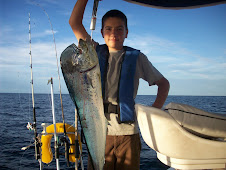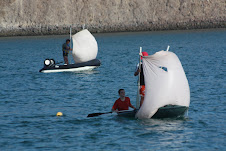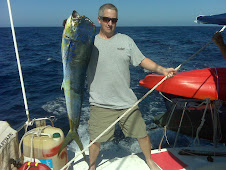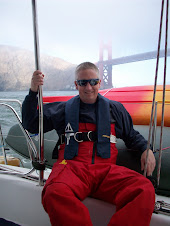
We had our second full night's sleep last night, and now we are recovered from our passage between La Paz and Chamela. The passage was just shy of four full days/nights and took us 92 hours, and covered about 450 nm miles.. We only used the engines on the last 40 miles when the wind was on our nose. This was the longest passage we have completed since arriving in Mexico and we learned some good lessons, had some scary moments, and lots of good sailing.
We left on a Norther, hoping for a good push to get us going. Unfortunately, the weather was a little stronger than the weatherman anticipated and the 6-8 foot swells at the top of the Cerralvo channel promised to be very nasty at the bottom of the channel where they funnel into a bottleneck, so we were obliged to sail around Cerralvo Island to avoid the channel. While that kept us out of a nasty situation, it meant a 20 mile detour to the East with the wind/seas on our beam, before we could turn the boat to the south and have the wind/seas on our stern. As I've mentioned before, it is no fun to have short period waves hitting a catamaran on the beam, especially when they are six foot high, short period waves in 20-25 knots of wind. It took seven hours from leaving our anchorage before we could start heading south on the outside of Cerralvo Island - it was a very long, unfortunate, uncomfortable start to our journey. Lesson learned on that was, "If you are leaving on a wind storm, position yourself in an anchorage where all you have to do is sail out of it and be immediately on your way."
Things got better quickly once we turned south, which was good since both Jack and I were getting very sick. The seas were pretty worked up, but mostly in one direction and as we moved further south and away from land, the waves became further spaced apart, which helped immensely. We were sailing wing on wing, using our spinnaker pole to hold the jib out to the side and were making about 8 - 9 knots. The rest of that day went well and we flew along.
Then, disaster. It was my watch and I was taking the time to clean the cabin windows before night set in. Since I was working, I wasn't paying as much attention and failed to see the small floating cube of styrofoam that bouyed a long-line, before it was too late. We didn't have time to turn and were hooked by a shark fisherman's long-line gear with its heavy poly-propalene line, thick steel leaders, and huge hooks. Being very concerned for our sail drives with the heavy line pulling on them and our boat sailing so fast, I immediately turned up in to the wind to stop our boat. Unfortunately, the wind was about 20 knots and the spinnaker pole was still attached to the jib. When we turned up into the wind, the jib was back-winded against the bamboo spinnaker pole and SNAP went the pole. It exploded spectacularly into pieces. If there was a choice to make between saving the pole or the sail drive, the sail drive would always win, but we were heartsick anyway. We love that spinnaker pole and used it often for wing on wing sailing - our favorite, most comfortable, and fastest way to sail. Lesson learned - "The person on-watch, needs to BE ON-WATCH, not distracted by other things." I thought I knew that, but I guess I didn't.
Since we were under sail, the engines were not going, but the lines were wrapped up around the sail drive and we couldn't get it loose. Night was falling and the seas and winds were still high, so it wasn't safe for Patrick to go swimming right then. We simply cut ourselves free from the styrofoam and tied the dangling lines up to our stanchion, to deal with later. We turned back on course and cleaned up the pieces of the spinnaker pole. We couldn't hold a wing on wing course anymore without the pole, so our speed dropped down to 5 and 6 knots. Bummer.
The next day, the wind was lessening to 15 knots, and the seas were down to 4-5 feet, but Patrick still wasn't feeling comfortable about jumping in to untangle the sail drive - until he noticed a funny whine that was coming from that area of the boat. We turned up-wind again, dropped the main, backwinded a small section of the jib, turned the rudders toward the wind, and hove-to. Heaving-to makes the wind push you one way, and the rudder, the other. This effectively holds your boat slightly nose into the waves, but moving only at .5 to 1 knot. Patrick suited up, tied a big rope around his waist and jumped in. He quickly unwrapped the pieces of poly-propalene and ascertained that both sail drives appeared undamaged. Once back on board, we started up the engines to test them and found them undamaged. We quickly got the sails back up, turned off the engines, and started on our way again.
The wind kept lessening over the rest of that day and night until finally we were able to use our spinnaker on Day 3. It was a joy to travel along on the flattening seas, pulling along at a good clip in the gentle breeze. For safety, we pulled the spinnaker in at night and continued on with the regular sails. Our power drain at night was remarkable due to the demands of the auto-pilot, GPS, and the navigation lights, along with the regular drains of fridge, lights, etc. Adding to the fact that the skies were overcast, so our solar power was not very effective. At night, with the auto and nav lights on, we were draining over 30 amps per hour. This was the first time we had seen the effects of a long sailing, passage. Lesson learned, "If we were going on a big passage like a puddle jump, we would need a wind generator or our power usage would have to seriously change." Another thing we learned was that our helm seat is akin to a torture device over a longer passage. Good thing we have no plans to do a puddle-jump.
Day 4 was very similar to the previous day. The wind kept lessening a bit, down to about 8 knots. We threw up the spinnaker again. Unfortunately, I did not get the spinnaker sock finished before we left and so we still needed to use the main as a wind blanket. However, the main had been flogging around horribly in the swell and light wind. The wind was forecasted to continue lessening, so we decided to leave the main down. Well, guess what happened? The wind picked up right before sunset, right before we were going to drop the spinnaker anyway. We all talked our parts through and went up to pull it down, with the winds at about 15 knots. Patrick threw off the one bottom line on the spinnaker and all hell broke loose. 46 feet by 25 feet of fabric started whipping about in the wind. It was exciting. Working all together, we had trouble getting that wild thing safely on the nets. But we did, no injuries outside of a friction burn on my hand, and a few pulled back muscles. Lesson learned - "Don't screw around with spinnakers - either use a sock or use the main - but you have to have some way to control it."
That craziness happened at sunset and we were still 70 miles out of Barra de Navidad, our destination. I was feeling battered, bruised, and tired from lack of sleep. So when the wind switched around from a light NW (oh, did I mention that right after we dropped the spinnaker the wind died right off?) to a light breeze from the SE, I was done. Suddenly we were nose into the wind, on a long stretch of highly trafficked water, at night. It was going to be a long night Patrick took pity on me and suggested we pull into Chamela which was just 30 more miles on. Going into an anchorage at night is asking for trouble, but I jumped at the suggestion. We had a few things in our favor. We had been there before, we had the waypoints from our earlier trip, Chamela is a large bay with a mile wide entrance, no rock obstacles and a sand bottom, there was a full moon, and we had an excellent guide book with more waypoints. Using our GPS and radar as guides we pulled safely into the anchorage and dropped our hook exactly 92 hours from our start time.
We left on a Norther, hoping for a good push to get us going. Unfortunately, the weather was a little stronger than the weatherman anticipated and the 6-8 foot swells at the top of the Cerralvo channel promised to be very nasty at the bottom of the channel where they funnel into a bottleneck, so we were obliged to sail around Cerralvo Island to avoid the channel. While that kept us out of a nasty situation, it meant a 20 mile detour to the East with the wind/seas on our beam, before we could turn the boat to the south and have the wind/seas on our stern. As I've mentioned before, it is no fun to have short period waves hitting a catamaran on the beam, especially when they are six foot high, short period waves in 20-25 knots of wind. It took seven hours from leaving our anchorage before we could start heading south on the outside of Cerralvo Island - it was a very long, unfortunate, uncomfortable start to our journey. Lesson learned on that was, "If you are leaving on a wind storm, position yourself in an anchorage where all you have to do is sail out of it and be immediately on your way."
Things got better quickly once we turned south, which was good since both Jack and I were getting very sick. The seas were pretty worked up, but mostly in one direction and as we moved further south and away from land, the waves became further spaced apart, which helped immensely. We were sailing wing on wing, using our spinnaker pole to hold the jib out to the side and were making about 8 - 9 knots. The rest of that day went well and we flew along.
Then, disaster. It was my watch and I was taking the time to clean the cabin windows before night set in. Since I was working, I wasn't paying as much attention and failed to see the small floating cube of styrofoam that bouyed a long-line, before it was too late. We didn't have time to turn and were hooked by a shark fisherman's long-line gear with its heavy poly-propalene line, thick steel leaders, and huge hooks. Being very concerned for our sail drives with the heavy line pulling on them and our boat sailing so fast, I immediately turned up in to the wind to stop our boat. Unfortunately, the wind was about 20 knots and the spinnaker pole was still attached to the jib. When we turned up into the wind, the jib was back-winded against the bamboo spinnaker pole and SNAP went the pole. It exploded spectacularly into pieces. If there was a choice to make between saving the pole or the sail drive, the sail drive would always win, but we were heartsick anyway. We love that spinnaker pole and used it often for wing on wing sailing - our favorite, most comfortable, and fastest way to sail. Lesson learned - "The person on-watch, needs to BE ON-WATCH, not distracted by other things." I thought I knew that, but I guess I didn't.
Since we were under sail, the engines were not going, but the lines were wrapped up around the sail drive and we couldn't get it loose. Night was falling and the seas and winds were still high, so it wasn't safe for Patrick to go swimming right then. We simply cut ourselves free from the styrofoam and tied the dangling lines up to our stanchion, to deal with later. We turned back on course and cleaned up the pieces of the spinnaker pole. We couldn't hold a wing on wing course anymore without the pole, so our speed dropped down to 5 and 6 knots. Bummer.
The next day, the wind was lessening to 15 knots, and the seas were down to 4-5 feet, but Patrick still wasn't feeling comfortable about jumping in to untangle the sail drive - until he noticed a funny whine that was coming from that area of the boat. We turned up-wind again, dropped the main, backwinded a small section of the jib, turned the rudders toward the wind, and hove-to. Heaving-to makes the wind push you one way, and the rudder, the other. This effectively holds your boat slightly nose into the waves, but moving only at .5 to 1 knot. Patrick suited up, tied a big rope around his waist and jumped in. He quickly unwrapped the pieces of poly-propalene and ascertained that both sail drives appeared undamaged. Once back on board, we started up the engines to test them and found them undamaged. We quickly got the sails back up, turned off the engines, and started on our way again.
The wind kept lessening over the rest of that day and night until finally we were able to use our spinnaker on Day 3. It was a joy to travel along on the flattening seas, pulling along at a good clip in the gentle breeze. For safety, we pulled the spinnaker in at night and continued on with the regular sails. Our power drain at night was remarkable due to the demands of the auto-pilot, GPS, and the navigation lights, along with the regular drains of fridge, lights, etc. Adding to the fact that the skies were overcast, so our solar power was not very effective. At night, with the auto and nav lights on, we were draining over 30 amps per hour. This was the first time we had seen the effects of a long sailing, passage. Lesson learned, "If we were going on a big passage like a puddle jump, we would need a wind generator or our power usage would have to seriously change." Another thing we learned was that our helm seat is akin to a torture device over a longer passage. Good thing we have no plans to do a puddle-jump.
Day 4 was very similar to the previous day. The wind kept lessening a bit, down to about 8 knots. We threw up the spinnaker again. Unfortunately, I did not get the spinnaker sock finished before we left and so we still needed to use the main as a wind blanket. However, the main had been flogging around horribly in the swell and light wind. The wind was forecasted to continue lessening, so we decided to leave the main down. Well, guess what happened? The wind picked up right before sunset, right before we were going to drop the spinnaker anyway. We all talked our parts through and went up to pull it down, with the winds at about 15 knots. Patrick threw off the one bottom line on the spinnaker and all hell broke loose. 46 feet by 25 feet of fabric started whipping about in the wind. It was exciting. Working all together, we had trouble getting that wild thing safely on the nets. But we did, no injuries outside of a friction burn on my hand, and a few pulled back muscles. Lesson learned - "Don't screw around with spinnakers - either use a sock or use the main - but you have to have some way to control it."
That craziness happened at sunset and we were still 70 miles out of Barra de Navidad, our destination. I was feeling battered, bruised, and tired from lack of sleep. So when the wind switched around from a light NW (oh, did I mention that right after we dropped the spinnaker the wind died right off?) to a light breeze from the SE, I was done. Suddenly we were nose into the wind, on a long stretch of highly trafficked water, at night. It was going to be a long night Patrick took pity on me and suggested we pull into Chamela which was just 30 more miles on. Going into an anchorage at night is asking for trouble, but I jumped at the suggestion. We had a few things in our favor. We had been there before, we had the waypoints from our earlier trip, Chamela is a large bay with a mile wide entrance, no rock obstacles and a sand bottom, there was a full moon, and we had an excellent guide book with more waypoints. Using our GPS and radar as guides we pulled safely into the anchorage and dropped our hook exactly 92 hours from our start time.
















Sounds like quite the passage. It always amazes me how there are always new lessons to be learned and how some of them still suck so much... Enjoy the French Baker for us:)
ReplyDelete